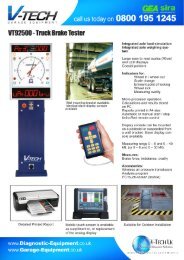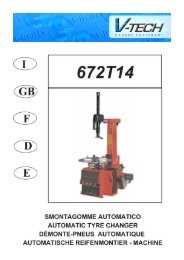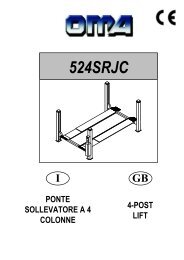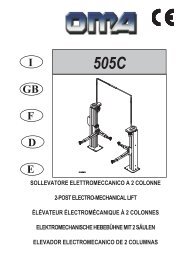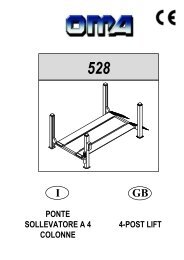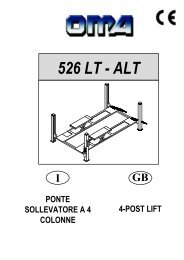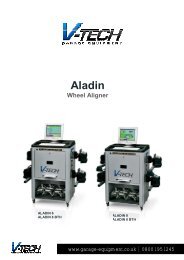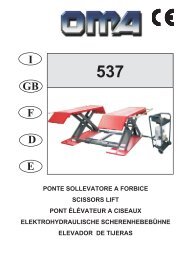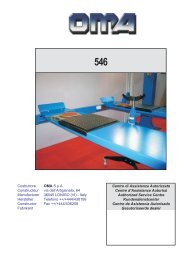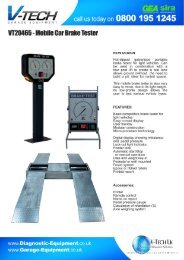sollevatore elettroidraulico a 2 colonne 2-post electro-hydraulic lift
sollevatore elettroidraulico a 2 colonne 2-post electro-hydraulic lift
sollevatore elettroidraulico a 2 colonne 2-post electro-hydraulic lift
You also want an ePaper? Increase the reach of your titles
YUMPU automatically turns print PDFs into web optimized ePapers that Google loves.
in caso di avaria completa dei microinterruttori, i carrelli si fermerebbero<br />
pochi mm più in alto perché i cilindri idraulici andrebbero<br />
a fine corsa facendo intervenire la valvola di massima pressione<br />
sulla centralina.<br />
If the <strong>hydraulic</strong> cylinder breaks, the safety wedges will trip (ref.1,<br />
see.fig.18), located inside the <strong>post</strong>s (2). The wedges are pushed<br />
by the spring (3) and immediately stop the carriages (4) preventing<br />
their descent<br />
2<br />
3<br />
1 4<br />
1<br />
2<br />
CARRELLO IN FASE<br />
DI DISCESA<br />
DESCENDING<br />
CARRIAGE<br />
CARRELLO IN FASE<br />
ARRESTO O SALITA<br />
STOPPING OR RISING<br />
CARRIAGE<br />
Fig.18<br />
Fig.19<br />
nel caso vengano sollevati autoveicoli di altezza superiore a 1,5<br />
metri, la salita viene interrotta dalla “barra di finecorsa” (rif.1<br />
Fig.20) che, spinta dal veicolo, agisce sui microinterruttori.<br />
in caso di extra corsa della parte mobile, sono stati previsti due<br />
microinterruttori (rif.2 e 3 Fig.20) collegati in serie tra loro e montati<br />
nella parte superiore della colonna lato comando; essi sono<br />
azionati normalmente dall’ “azionatore” (rif.1 Fig. 19) montato sul<br />
carrello lato comando; nel caso che il primo microinterruttore<br />
non dovesse funzionare, il secondo interviene dopo circa 30 mm<br />
di corsa del carrello.<br />
in caso di rottura del cilindro idraulico intervengono automaticamente<br />
i martelletti di sicurezza (rif.1) (vedere Fig.18), <strong>post</strong>i all’ interno<br />
delle <strong>colonne</strong> (2), che, spinti dalla molla (3), arrestano immediatamente<br />
i carrelli (4) impedendone la discesa.<br />
When vehicles higher than 1.5m are <strong>lift</strong>ed, the rise is interrupted<br />
by the “end-stroke bar “(ref.1, fig.20), which, pushed by the<br />
vehicle, works on the limit switches.<br />
if the moving part exceeds its travel distance, on the upper part<br />
of the command <strong>post</strong> there are two limit switches (ref.2 and 3,<br />
fig.20) connected in series and are usually set working by the<br />
“actuator” (ref.1 fig.19) on the command side carriage. If the first<br />
limitswitch did not work, the second one would trip after 30 sec.<br />
of carriage run.<br />
in case of total breakdown of the limitswitches, the carriages will<br />
stop a few mm higher, because the <strong>hydraulic</strong> cylinders, come to<br />
endstroke, will cause the maximum pressure valve (on <strong>hydraulic</strong><br />
unit) to trip.<br />
3<br />
Fig.20<br />
1<br />
2<br />
16




